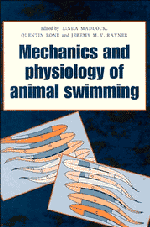Book contents
- Frontmatter
- Contents
- Contributors
- Introduction
- 1 Functional patterns of swimming bacteria
- 2 Buoyancy and swimming in marine planktonic protists
- 3 The role of fins in the competition between squid and fish
- 4 The biology of fish swimming
- 5 Swimming physiology of pelagic fishes
- 6 The mechanical design of the fish muscular system
- 7 How do fish use their myotomal muscle to swim? In vitro simulations of in vivo activity patterns
- 8 The timing of lateral muscle strain and EMG activity in different species of steadily swimming fish
- 9 Swimming in the lamprey: modelling the neural pattern generation, the body dynamics and the fluid mechanics
- 10 Swimming capabilities of Mesozoic marine reptiles: a review
- 11 Stone, bone or blubber? Buoyancy control strategies in aquatic tetrapods
- 12 Functional anatomy of the ‘flight’ apparatus in penguins
- 13 Energy conservation by formation swimming: metabolic evidence from ducklings
- Bibliography
- Index
Introduction
Published online by Cambridge University Press: 05 March 2012
- Frontmatter
- Contents
- Contributors
- Introduction
- 1 Functional patterns of swimming bacteria
- 2 Buoyancy and swimming in marine planktonic protists
- 3 The role of fins in the competition between squid and fish
- 4 The biology of fish swimming
- 5 Swimming physiology of pelagic fishes
- 6 The mechanical design of the fish muscular system
- 7 How do fish use their myotomal muscle to swim? In vitro simulations of in vivo activity patterns
- 8 The timing of lateral muscle strain and EMG activity in different species of steadily swimming fish
- 9 Swimming in the lamprey: modelling the neural pattern generation, the body dynamics and the fluid mechanics
- 10 Swimming capabilities of Mesozoic marine reptiles: a review
- 11 Stone, bone or blubber? Buoyancy control strategies in aquatic tetrapods
- 12 Functional anatomy of the ‘flight’ apparatus in penguins
- 13 Energy conservation by formation swimming: metabolic evidence from ducklings
- Bibliography
- Index
Summary
Aquatic organisms swim in a variety of ways, from jet propulsion to ciliary action; they swim at a wide range of speeds and span a vast size range, from bacteria and protists, to the largest whales. In consequence of the enormous size and speed range of swimming organisms, they operate under notably different Reynolds number regimes. This has led to very different selection pressures in different forms, and one of the fascinating aspects of aquatic locomotion is the remarkable sets of adaptations that have been evolved for different purposes. These are seen not only in external form, as in the body shapes of fish, penguins, and fossil marine reptiles, but also in the way the locomotor muscles are designed and controlled, and in the structure of the skeleton.
The different chapters consider some of the problems faced by swimmers from several points in the vast array of aquatic organisms, from the biological and physical effects determining the patterns of bacterial populations, to the remarkable special adaptations of penguins for underwater ‘flight’. All organisms are constructed from materials that are denser than the water in which they swim. To avoid sinking either they must use buoyancy strategies, such as changing in shape, as do some marine protists, or storing light materials (like fat or gas) to provide static lift, or they must generate dynamic lift, as ichthyosaurs apparently did. Most fishes and all aquatic tetrapods have gas-filled swim bladders or lungs and hence are close to neutral buoyancy (at least at a particular depth). Some tetrapods, however, like penguins and plesiosaurs, can apparently achieve neutral buoyancy only by swallowing stones as ballast.
- Type
- Chapter
- Information
- The Mechanics and Physiology of Animal Swimming , pp. 1 - 2Publisher: Cambridge University PressPrint publication year: 1994
- 5
- Cited by

